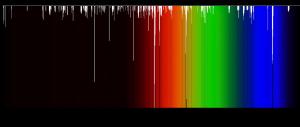Blog
Battle of the Bands
26 May 2014
 D. Kokkin, ASU
D. Kokkin, ASUWhen light passes through gas and dust in the interstellar medium, some of the light is absorbed. Since the gas and dust only absorb certain wavelengths or colors of light, by by looking at these absorption bands we can determine the type of material that makes up the interstellar media. Well, most of the time. It turns out there are a range of absorption bands that we haven’t been able to identify. They are known as diffuse interstellar bands.
One of the difficulties with these diffuse interstellar bands is that they don’t seem to match any known atoms or molecules. We know there are molecules that could form within the interstellar medium, but many of them haven’t been analyzed in the labs. Analyzing the line spectra of different compounds in a range of conditions such as vacuum and low temperatures is time consuming. Since it isn’t very glamorous, it doesn’t tend to get much funding, and that limits our ability to analyze the bands.
Another challenge is that different bands can be stronger or weaker relative to each other. This means they are likely due to a range of processes. There is some evidence that the strength of the bands correlates with the amount of dust in the region, so they are likely related to some kind of dust feature. Right now one of the favored ideas is that they are due to some kind of larger hydrocarbon molecule. But as for the details, we just don’t know.